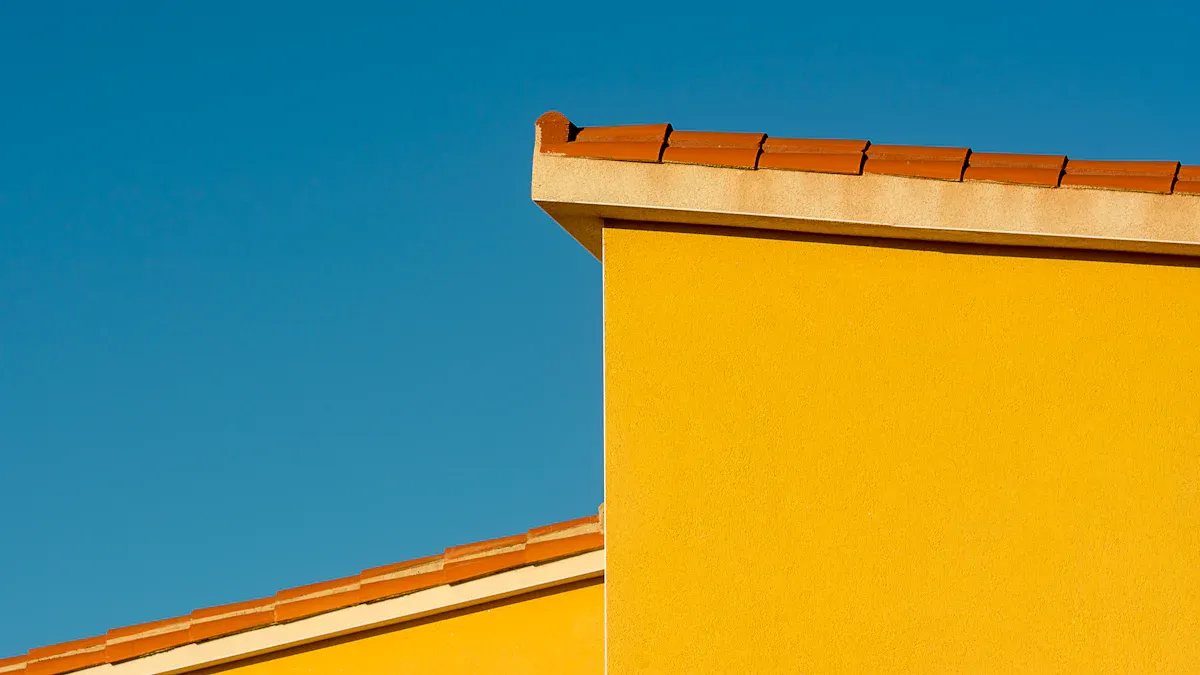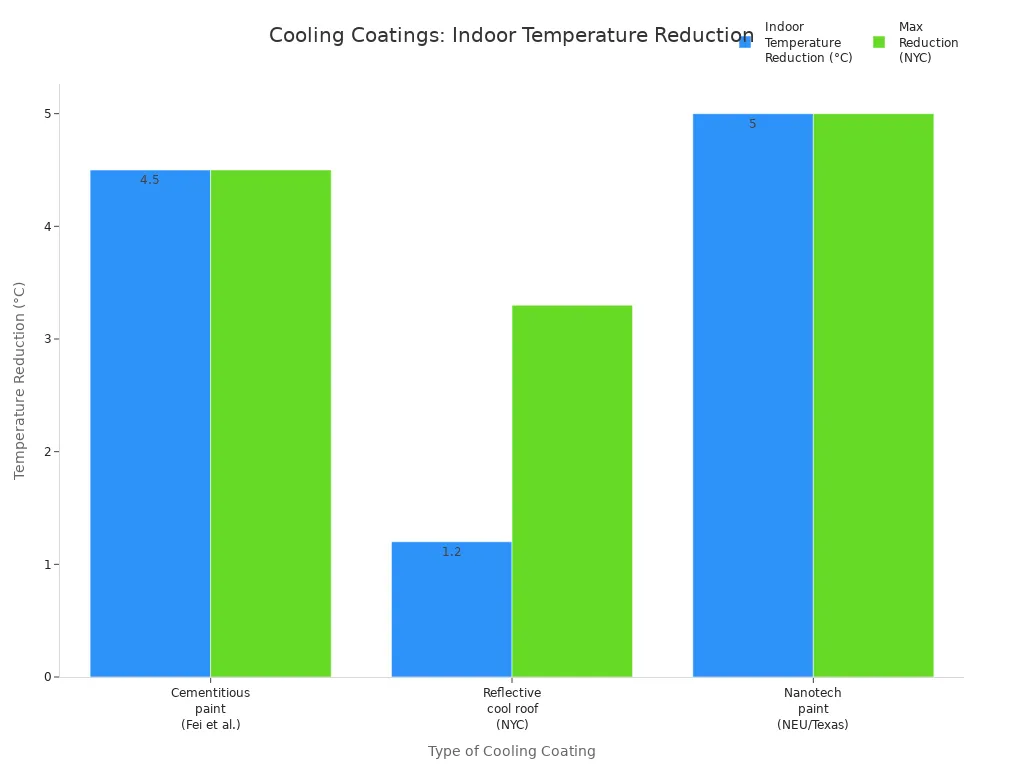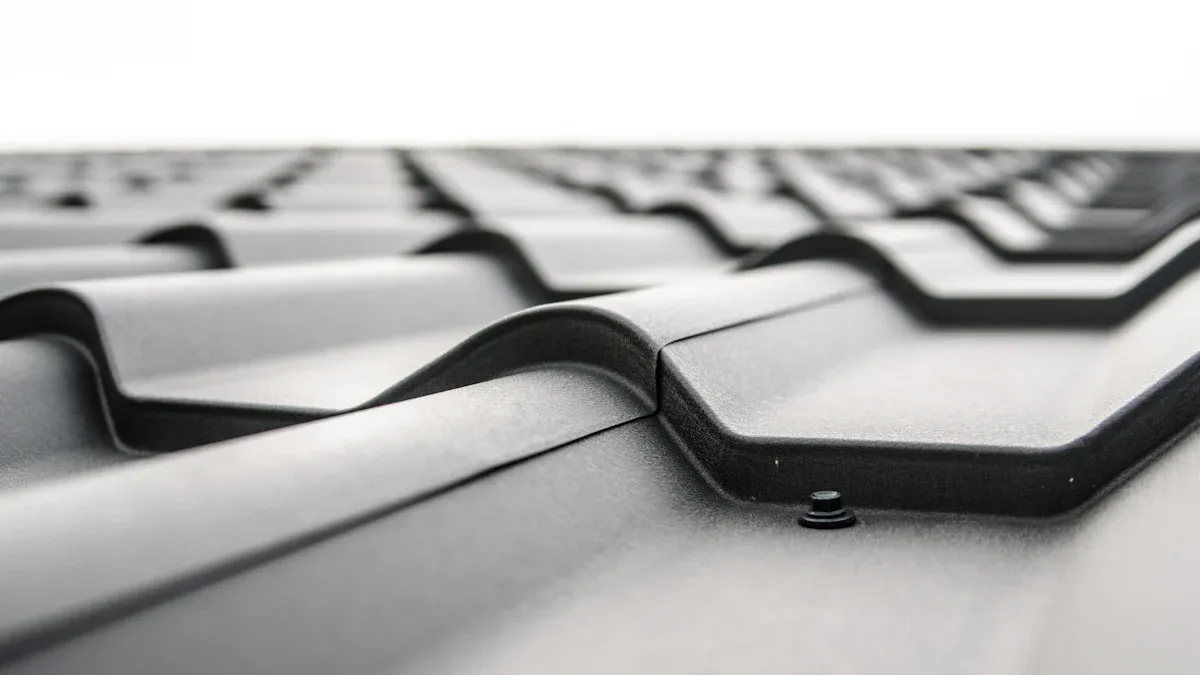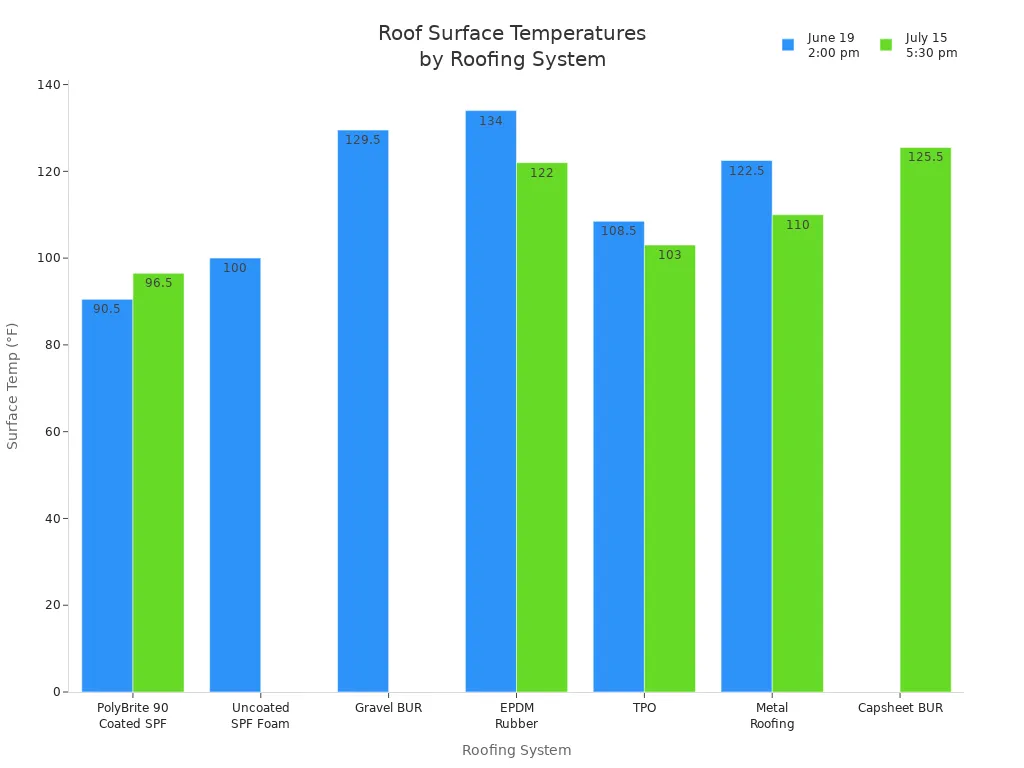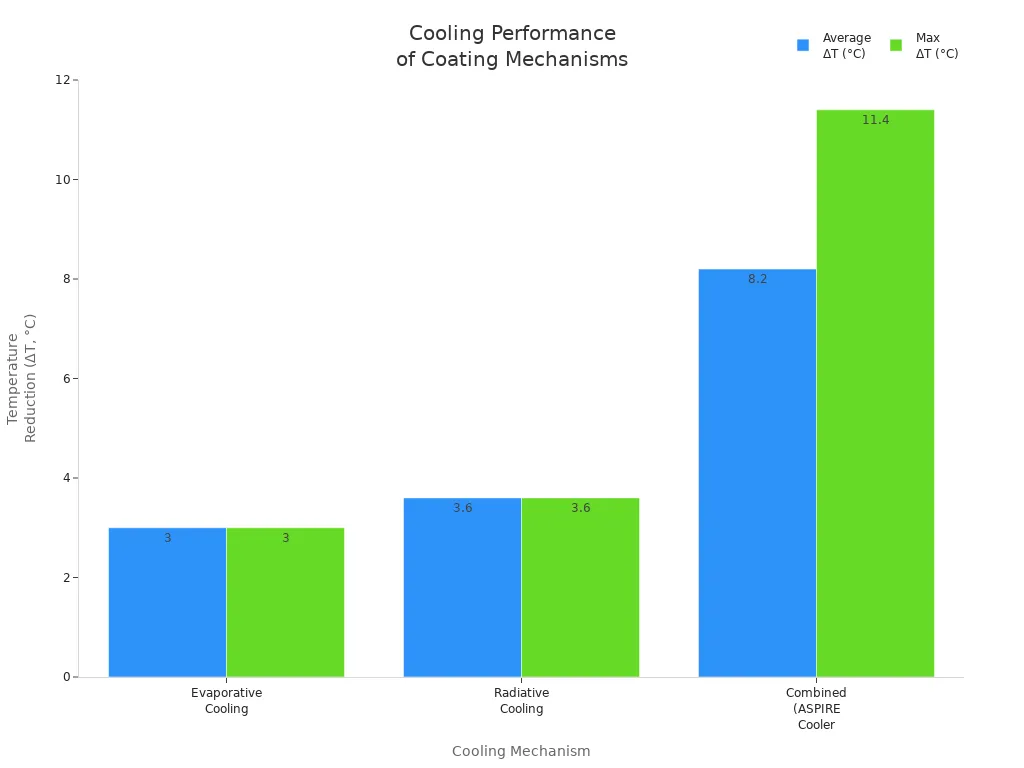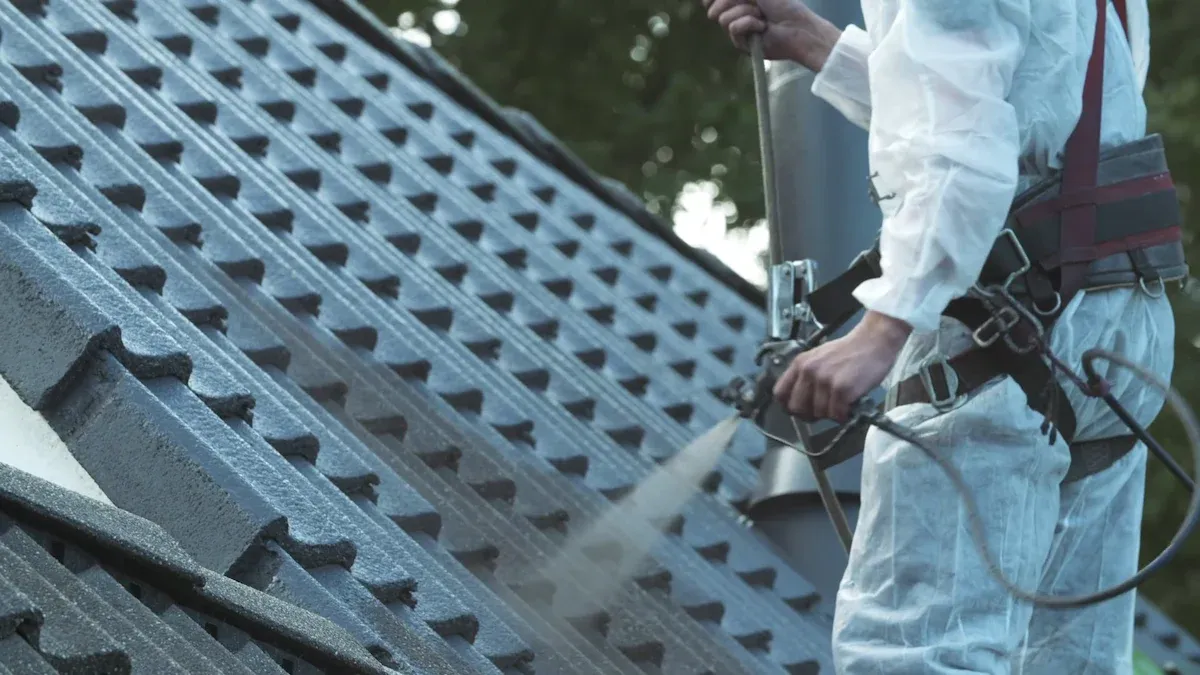You can keep your house cool in summer with a cooling coating. This coating reflects sunlight and stops heat from getting inside your home.
A cooling coating can reflect up to 90% of solar energy. Traditional roofs only reflect about 60-80%. This means less heat comes into your rooms. Your rooms stay cooler, even on very hot days.
| Roofing Material Type | Solar Reflectance Percentage |
|---|---|
| Cooling Coatings (Cool Roof Coatings) | Up to 90% or more |
| Traditional Roof Coatings | Around 60-80% |
You will see lower indoor temperatures. You will not need as much air conditioning. Your home will feel more comfortable. Cooling coatings also help the environment. They do this by lowering energy use.
Key Takeaways
- Cooling coatings can reflect up to 90% of sunlight. This helps keep your house cooler than normal roofs. These coatings let heat escape fast. This helps your roof cool down quickly. It also means you use less air conditioning. Advanced cooling coatings use special ways to cool. They use evaporative and radiative cooling to lower heat even more. Using cooling coatings can help you save money. They can cut energy use by up to 40% in hot places. You need to pick the right product and put it on the right way. You should also take care of it often. This helps your cooling coating work well and last longer.
How Cooling Coating Works
You want your house to stay cool in summer. The secret is how a cooling coating works on your roof or walls. This coating helps by reflecting sunlight and letting out heat. Some coatings use special ways to cool your home even more. All these things work together to keep your house cooler.
Keep reading to see how each part of this technology helps you stay cool.
Reflecting Sunlight
Light colors feel cooler than dark ones. This is because they bounce more sunlight away. Cooling coatings use this idea to help your house. They reflect a lot of the sun’s energy, like visible and infrared light. This is called high solar reflectance. It stops most heat from getting inside. The table below shows how this works:
| Scientific Principle | Explanation | Benefits |
|---|---|---|
| Reflectivity (Albedo) | Sends a lot of solar energy (visible and infrared light) back into the air, so buildings do not soak up as much heat. | 1. Less heat gets inside, so rooms stay cooler and you use less energy. 2. Roofs last longer because they do not get as hot. 3. Cooler surfaces help lower city temperatures. |
With a cooling coating, your roof can reflect up to 40% more sunlight than normal roofs. Studies say this can cut your cooling energy use by up to 20% in hot places. Some coatings have special pigments that reflect ultraviolet and infrared rays. These work better than regular white paint.
Tip: The color and type of coating matter. Near-infrared reflective coatings can make your walls and indoor air up to 2.9°C cooler than regular coatings.
Emitting Heat
Reflecting sunlight is just one part. Your roof also needs to get rid of heat it takes in. This is called thermal emittance.
A cooling coating with high thermal emittance lets out heat as infrared radiation. This helps your roof cool down fast, especially after sunset. The table below explains this:
| Scientific Principle | Explanation | Benefits |
|---|---|---|
| Emissivity | Lets a material send out heat as thermal radiation, which works best at night. | 1. Roof cools faster after sunset. 2. You need less air conditioning at night, so you save energy. 3. Roofs do not get as hot, so they last longer. |
Many cooling coatings, like metal oxide coatings, have thermal emittance values up to 0.9. This means they can let out most of the heat they take in. Tests show that roofs with these coatings can be over 20% cooler during the hottest part of the day than regular roofs.
Note: Cooler roofs mean less heat comes inside, so your air conditioner does not have to work as hard.
Evaporative and Radiative Cooling
Some cooling coatings use extra ways to keep your house cool. These are called evaporative and radiative cooling.
Evaporative cooling uses water to soak up heat as it dries. Radiative cooling sends heat away from your roof by letting out infrared rays into space. Some coatings use both ways for even better results. The table below compares these:
| Cooling Mechanism | Key Principle | Performance Highlights |
|---|---|---|
| Evaporative Cooling | Uses water drying from special networks (like hydrogels) to soak up heat | Can cool about 3 °C below outside temperature under strong sun; works best when it is not too humid |
| Radiative Cooling | Bounces sunlight away and sends long-wave IR into space | Can cool about 3.6 °C below outside temperature under the same sun; works best on clear days but does not use water |
| Combined (ASPIRE Cooler) | Uses insulation, radiation, and evaporation together | Can cool an average of 8.2 °C and up to 11.4 °C below outside temperature during strong sun; works better than just one method |
You get the best results when these features work together. For example, a test in China showed that homes with radiative cooling coatings had daily temperature differences up to 71.91% higher than homes without them. Computer studies also found that these coatings can make roof surfaces cooler than the air inside, which saves energy and makes your home more comfortable.
Advanced materials, like special nanoparticles and layered designs, make these coatings work better and last longer. They also help the environment by using materials that can be recycled and stay strong.
Cooling Coating Benefits
Lower Indoor Temperatures
You want your house to stay cool, even on hot days. High heat can make your home feel uncomfortable and hard to enjoy. A cooling coating helps by bouncing sunlight away and letting heat out. Some people used yogurt on windows and saw their homes get 1°F cooler over a month. On very sunny days, the temperature dropped by up to 6.3°F. Metallic coatings on special roofs can make them up to 11°C cooler than normal roofs. This means your house can be cooler than the air outside, especially during heat waves.
Tip: A cooler roof or wall keeps your rooms nice and helps protect your furniture from heat.
Energy Savings
When it is hot inside, your air conditioner works harder. This makes your energy bills go up and wears out your cooling system faster. A cooling coating can help you save money because you do not need as much air conditioning. The table below shows how much energy you can save in different places:
| Climate Zone | Energy Savings (%) |
|---|---|
| Hot (Texas) | 20-40 |
| Warm (California) | 10-20 |
| Mild (Oregon) | 5-10 |
| Cool (New York) | 2-5 |
Cool roof coatings can lower your energy use by 10-15% on average. In some cases, you can save up to 46% on electricity during summer. Many states, like California and Texas, want people to use these coatings because they help lower air conditioning use and cut utility bills.
Comfort and Environment
You want your house to feel safe and comfortable, even when it is very hot. Cooling coatings help you reach this goal.
- Cool roofs can make your house up to 50°F cooler than regular roofs.
- These coatings keep your home nice during heat waves and mean you do not need as much air conditioning.
- Using less energy means fewer greenhouse gases and less stress on the power grid.
- Cooling coatings help make cities cooler and healthier by fighting the urban heat island effect.
- Reflective coatings help your roof last longer and make solar panels work better.
Note: If you use cooling coatings with good insulation and ventilation, you get the best comfort and energy savings all year.
Choosing and Applying Cooling Coatings
You want your house to stay cool and save money. Picking the right cooling coating and putting it on well is important. You get the best results by choosing a good product, getting your roof ready, and taking care of it. With the right steps, your house can stay cooler all summer.
![Image placeholder: Person applying roof coating with a roller]
You may ask how to choose the best product and use it right. Here is what you should know.
Product Selection
To pick the right cooling coating, look for key features. These include:
- High solar reflectance to bounce sunlight away and keep your roof cool.
- High thermal emittance to help your roof let out heat fast.
- ENERGY STAR® or Cool Roof Rating Council (CRRC) certification for trusted results.
- Products tested for strength, like a three-year weather test.
- Make sure it fits your climate, roof type, and building style.
- Rebates or deals from local utilities to help with costs.
- For synthetic roofs, check for fire and impact resistance and a strong warranty.
| Feature | Why It Matters |
|---|---|
| Solar Reflectance | Keeps roof surface cooler |
| Thermal Emittance | Releases heat efficiently |
| CRRC/ENERGY STAR® Rated | Ensures tested, reliable performance |
| Durability | Lasts longer, saves money |
| Incentives | Lowers installation costs |
Tip: CRRC-rated products give you good facts to compare choices.
Application Tips
Putting on the coating the right way helps it last longer and work better. Follow these steps:
- Clean the roof to get rid of dust, algae, and loose stuff.
- Fix cracks with sealant or filler.
- Look for water damage or leaks and repair them.
- Use a primer coat if your roof is old.
- Put on the coating with a brush, roller, or spray. Make sure you use the right amount for best results.
Spray methods work well for big roofs and give a smooth finish. Rollers and brushes are good for small spots or fixing areas. Let each coat dry before adding another one.
Note: The right thickness and clean surface help your coating last longer.
Maximizing Results
You can keep your roof cool for a long time with simple care:
- Check your roof at the start of each summer.
- Clean off leaves and dirt and look for damage.
- Fix any problems right away.
- Upgrade your coating when new products come out.
Regular checks help you find problems early. Cleaning and repairs keep your cooling coating working well. Some utility companies give rebates for upgrades, so look for local programs.
| Maintenance Task | How Often | Why It Helps |
|---|---|---|
| Inspection | Start of summer | Catches problems early |
| Cleaning | As needed | Keeps surface reflective |
| Repairs | When needed | Prevents bigger issues |
| Upgrades | Every few years | Improves performance |
Tip: Keeping your roof in good shape means more comfort and bigger energy savings.
Cooling Coating vs Other Methods
You want your house to stay cool in summer. You might wonder if other ways work better. Many people look at different cooling methods to see what is best. You can use insulation, ventilation, landscaping, and shade with reflective coatings. This helps you feel comfortable and save money. Each way has its own good points. Using them together often works best.
![Image placeholder: Comparison of cooling methods for homes]
Let’s see how these ways compare and when to use them together.
Insulation and Ventilation
Insulation and ventilation do not work the same as reflective coatings. Insulation keeps cool air inside and blocks heat from coming in. Ventilation moves hot air out and brings in fresh air.
| Feature | Insulation | Ventilation | Reflective Coatings |
|---|---|---|---|
| Main Function | Blocks heat transfer | Moves hot air out | Reflects sunlight, emits heat |
| Cost per sq. ft. | $0.80–$4.00 | Varies by system | Often higher than insulation |
| Energy Savings | High | Moderate | Moderate to high |
| Best For | All climates | Hot, humid climates | Hot, sunny climates |
Fiberglass or foam insulation gives strong protection from heat and saves energy. It usually costs less and works all year. Reflective coatings do not take the place of insulation. They help most in hot, sunny places. Ventilation systems like attic fans or vents move heat and moisture out. This stops mold and helps your roof last longer. You get the best results when you use all these ways together.
Landscaping and Shade
Trees and shade structures can cool your house in a natural way. Shade trees block sunlight before it hits your roof or windows. Deciduous trees give shade in summer and let sun in during winter.
| Aspect | Shade Trees | Reflective Coatings |
|---|---|---|
| Cooling Mechanism | Blocks sun, cools air | Reflects sunlight |
| Cooling Effectiveness | Up to 25% energy savings | Up to 30°C roof temp reduction |
| Cost (10-year avg.) | Higher (includes maintenance) | Lower (less maintenance) |
| Extra Benefits | Improves comfort, adds beauty | Protects roof, saves energy |
Shade structures can make outdoor areas cooler by 15–20°F. If you use shade and reflective coatings together, your home will be even cooler. This also lowers your cooling bills.
Unique Value
Reflective coatings have special benefits that other ways do not give:
- Reflect up to 90% of sunlight and let heat out fast.
- Make roofs up to 30°C cooler and cut indoor heat by 30%.
- Lower air conditioning use by 10–30% and save money.
- Help stop your roof from cracking or getting damaged.
- Work as a strong, long-lasting shield against heat, dust, and rain.
- Help the planet by using less energy and fighting city heat.
You get the most from coatings when you use them with insulation, ventilation, and shade. This works best in hot, sunny places or where the weather changes a lot.
These coatings bounce sunlight away and let heat out. This helps your home stay cooler. You use less energy and pay lower bills. It is also good for the environment. These coatings do things that insulation or shade cannot do. You should look up trusted products or ask a local expert for help.
FAQ
How long does a cooling coating last?
Most cooling coatings last 5–10 years. You can extend the life by cleaning your roof and checking for damage each year. Some products offer warranties for extra peace of mind.
Tip: Regular maintenance helps your coating work better and last longer.
Can you apply cooling coatings to any roof?
You can use cooling coatings on many roof types, like metal, asphalt, or concrete. Some coatings work best on flat roofs. Always check the product label to see if it matches your roof material.
| Roof Type | Compatible? |
|---|---|
| Metal | Yes |
| Asphalt | Yes |
| Tile | Sometimes |
| Wood | Rarely |
Will a cooling coating change the look of your house?
Most coatings come in white or light colors. Some brands offer tints. You may notice a brighter roof, but the change is often subtle. You can choose a color that fits your home’s style.
Do cooling coatings help in winter?
Cooling coatings mainly reflect summer heat. In winter, they do not add warmth. You still need good insulation to keep your house warm during cold months.
Note: Cooling coatings work best when combined with insulation for year-round comfort.
Are cooling coatings safe for the environment?
Many cooling coatings use water-based formulas and low-VOC materials. These choices help protect air quality and reduce pollution. You help the planet by using less energy and lowering greenhouse gas emissions.

